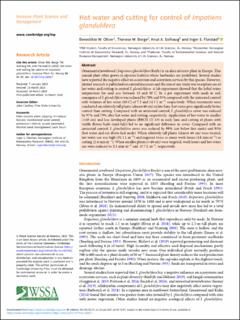Hot water and cutting for control of Impatiens glandulifera
Peer reviewed, Journal article
Published version
Permanent lenke
https://hdl.handle.net/11250/2826845Utgivelsesdato
2020Metadata
Vis full innførselSamlinger
Sammendrag
Ornamental jewelweed (Impatiens glandulifera Royle) is an alien invasive plant in Europe. This annual plant often grows in riparian habitats where herbicides are prohibited. Several studies have reported the negative effect on ecosystem and ecosystem services by this species. However, limited research is published on control measures and the aim of our study was to explore use of hot water and cutting to control I. glandulifera. A lab experiment showed that the lethal water temperature for seed was between 45 and 50 C. In a pot experiment with seeds in soil, emergence of I. glandulifera was reduced by 78% and 93% compared with the untreated control with volumes of hot water (80 C) of 7.2 and 14.5 L m−2, respectively. When treatments were conducted on relatively tall plants (almost 60 cm) in late June, hot water gave significantly better control than cutting. Compared with an untreated control, I. glandulifera cover was reduced by 97% and 79% after hot water and cutting, respectively. Application of hot water to smaller (<40 cm) and less developed plants (BBCH 12–13) in early June and cutting of plants with visible flower buds (mid-July) led to no significant difference in cover. Compared with an untreated control, I. glandulifera cover was reduced by 99% (cut below first node) and 91% (hot water and cut above first node). When relatively tall plants (almost 60 cm) were treated, hot water use was high (31.1 L m−2) and required twice as many work hours (4.8 min m−2) as cutting (2.4 min m−2). When smaller plants (<40 cm) were targeted, work hours and hot water use were reduced to 2.1 min m−2 and 13.7 L m−2, respectively.
